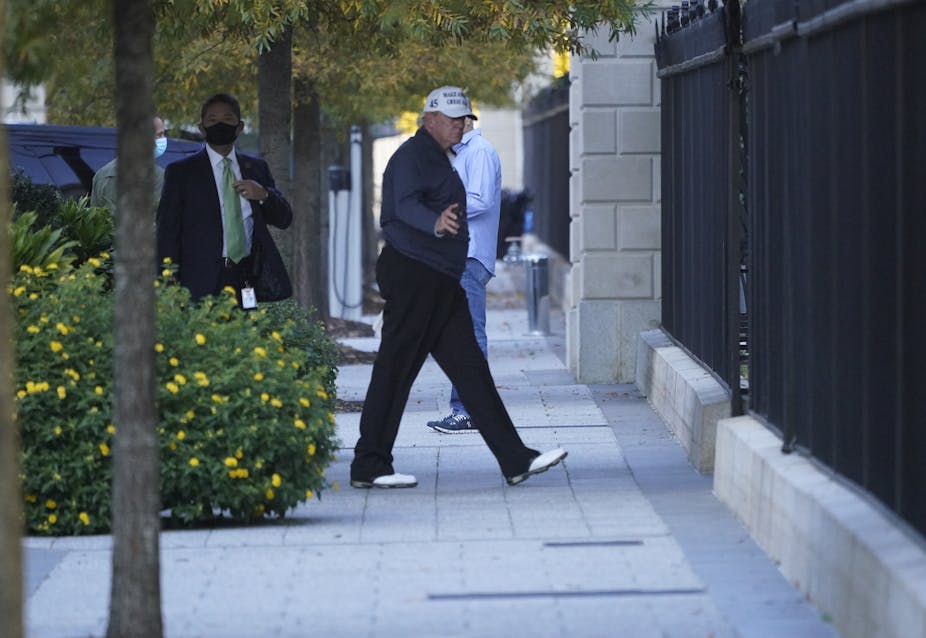Now Joe Biden has been declared the winner of the US presidential election, many analysts are looking ahead to what a Biden presidency might mean for America and the world.
In the meantime, the US political system has entered a state of suspended animation. As we await the final vote tallies, with law suits underway and recounts expected across several states, at least one thing is for certain: Donald Trump will still hold the keys to the White House until at least January 20.
But what does that mean for US foreign policy?
Observers were quick to connect events overseas with the electoral process in the months leading up to polling day, with much speculation about an “October surprise” and foreign election interference. Yet the presidential transition that follows remains “among the least studied moments of potential mayhem in the US political system”, as the historian Timothy Naftali recently noted.
A closer look at the historical record suggests that what happens in the coming weeks may leave a lasting imprint on foreign policy for years to come.
Read more: October surprise: how foreign policy can shape US presidential elections
Lame duck activism
While outgoing presidents are often characterised as “do-nothing” presidents, the lame duck term between the election and inauguration is something of a misnomer. In fact, studies demonstrate that incumbents in the twilight phase of their term are surprisingly active in foreign affairs.
Bound by relatively few constraints, outgoing presidents turn increasingly to diplomacy and even the use of force as a means to cement their legacy. These efforts often yield limited strategic results. But thanks to the credibility and commitment problems associated with this stage of the electoral cycle, actions of outgoing presidents nevertheless serve to tie a successor’s hands as they seek to chart a new course.
In December 2008, for example, George W Bush sought to lock in the perceived gains of his “surge” strategy during the Iraq War by signing a three-year Status-of-Forces Agreement governing the continued presence of US forces in Iraq.
“He wanted to influence the actions of the successor government,” the former deputy secretary of state, John Negroponte, later told me as part of my ongoing research. The president’s weak bargaining leverage led him to reluctantly agree to Iraqi demands for a fixed timetable governing the drawdown of US troops. Negroponte said that Bush conceded because he was “guarding against the advent of a Democratic president” who had previously committed to a complete withdrawal of US troops from the country. In the event, the incoming Obama administration found itself partially bound by its predecessor’s fait accompli.
Bush’s tactics were not lost on his successor. Eight years later, Obama exerted considerable energy creating legal and administrative hurdles for then President-elect Trump on issues ranging from energy policy to the Middle East peace process.
While decisions involving the use of force are comparatively rare, there is precedent here, too. In December 1992, George H W Bush sent almost 30,000 troops to Somalia on an open-ended humanitarian mission. The decision set US policy on a path that would ultimately lead to a political crisis for his successor, after 18 Americans were killed in Somalia during a special operations raid in October 1993.
Time will tell whether Trump will resort to similar moves. Administration officials reportedly began hedging against a Biden win prior to the election. Last-minute sanctions placed on Iran were apparently designed to build a “wall” of economic restrictions strong enough to thwart a future administration’s attempt to return to the 2015 nuclear deal.
The dismissal on November 9 of the secretary of defense, Mark Esper, may indicate Trump’s desire to remove bureaucratic obstacles to making more moves in this direction. The US presence in Afghanistan has long been a bête noire of the president, for instance, and it would not be surprising if he decides to accelerate the drawdown of US forces in Afghanistan in ways which would be politically difficult for the incoming president to reverse.

A disruptive transition
The scale and complexity of the handover process itself introduces an additional challenge. A presidential transition entails a massive turnover of political appointees throughout the executive branch. The notion that personnel is policy may be a cliché, but with hundreds of positions to fill and new structures to put in place, there is considerable scope for critical information about ongoing operations and imminent threats to become lost in transition.
The Bay of Pigs fiasco in April 1961 provides a cautionary tale of the pitfalls of poor coordination. Recent research indicates that the failure of the CIA-supported invasion of Cuba by anti-Castro forces can be traced back to inadequate intelligence briefings received by the President-elect, John F Kennedy, during the 1960 transition. By the time he was inaugurated, Kennedy had yet to receive a full briefing on the invasion plan. He faced intense pressure to authorise the covert operation – with ultimately disastrous results.
There has not been a foreign policy catastrophe of similar magnitude in recent years, in part thanks to updates to the Presidential Transition Act, which mandate a stronger degree of coordination between incoming and outgoing administrations. Yet they are not unheard of, and while Biden may surround himself with other veterans of previous administrations, their collective experience will only count for so much.
The Biden campaign made clear that it wouldn’t follow the past example of other incoming administrations in prematurely engaging with representatives of other nations. Given the prospect of an imminent crisis arising prior to or shortly after the inauguration, this only underlines the importance of ensuring a smooth transition.
Ultimately, an effective presidential handover requires the willing and timely cooperation of both sides. Trump has already delayed the transition process by challenging the legitimacy of the election outcome. Meanwhile, the Biden team has made no secret of its plans to undo many of the outgoing administration’s policies. We may be in for a bumpy ride.

